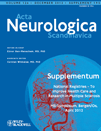Incidence and prevalence of multiple sclerosis in Norway
Abstract
The incidence and prevalence of multiple sclerosis in several Norwegian counties have been assessed in a number of epidemiological studies since the first nationwide study covering the period from 1935 to 1948. Although the observations are not continuous, a large increase in incidence and prevalence is reported in these studies. The most remarkable incline has taken place in western and northern Norway. Parallel to the observed increase in occurrence of multiple sclerosis (MS), the Norwegian society has gone through notable changes from being a poor country immediately after World War II to an affluent, modern nation today. Thus, the healthcare system and neurological services have improved. Readily accessible services contribute to a quicker and better case ascertainment. Also, a lower threshold among the public to seek help for symptoms thought to originate in the CNS is probable. Environmental factors of possible biological importance in MS have also changed, for example diet, smoking habits and exposure to ultraviolet radiation, but the knowledge of change in these factors is so far mainly on the population level. To explore these questions, a comprehensive national MS registry combined with detailed information of assumed environmental risk factors operating in parallel in the society might be an important tool to further knowledge.




